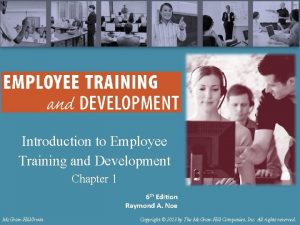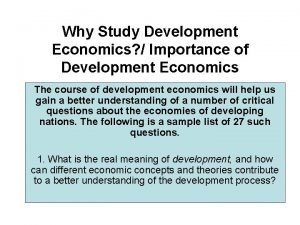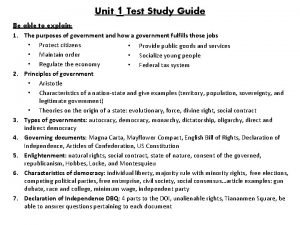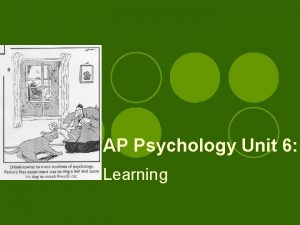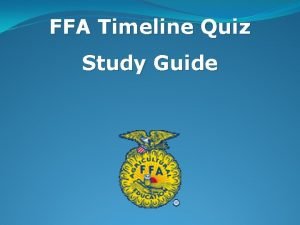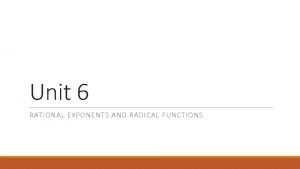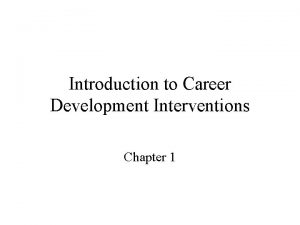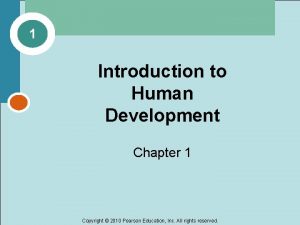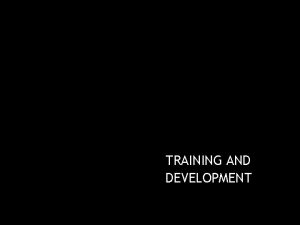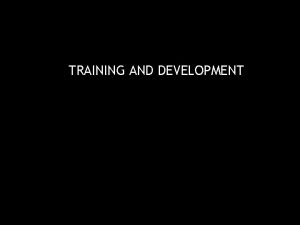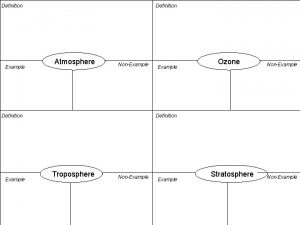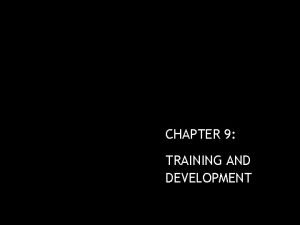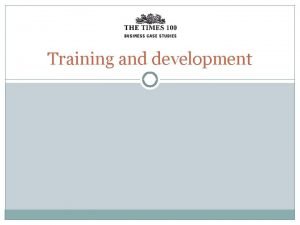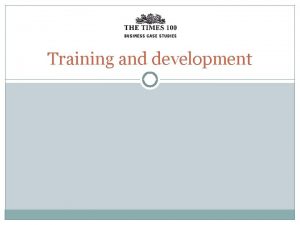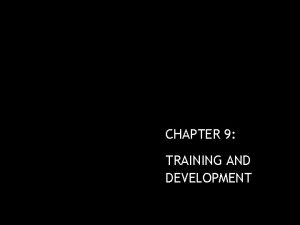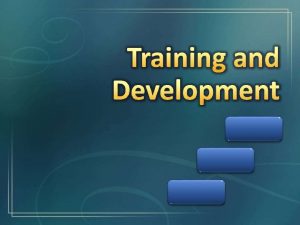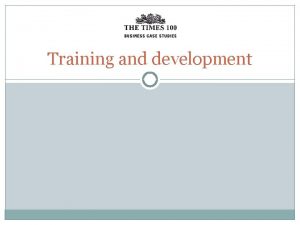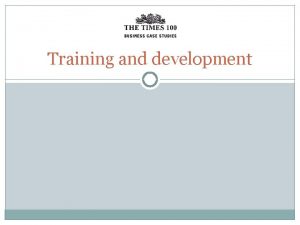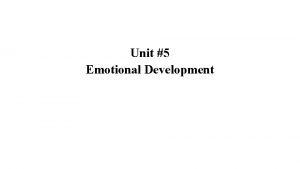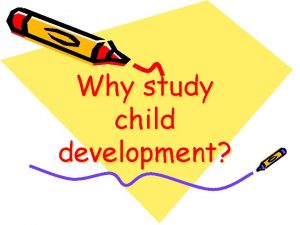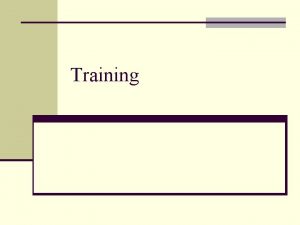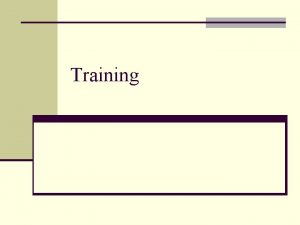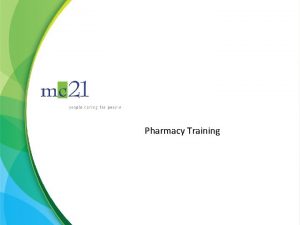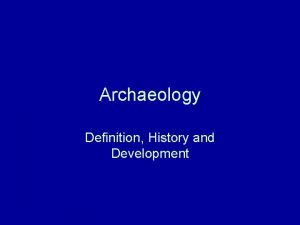STUDY UNIT 6 TRAINING DEVELOPMENT INTRODUCTION Training DEFINITION


































- Slides: 34

STUDY UNIT 6: TRAINING & DEVELOPMENT

INTRODUCTION Training DEFINITION (Goldstein & Ford, 2002): Training is the systematic acquisition of skills, rules, concepts, or attitudes, which result in improved performance at work • Organisations choose employees based on the belief that they will be successful in their jobs. • Employees must enhance capabilities to keep performing. • Most employees are provided with the time to grow within their “new capacities”.

… INTRODUCTION • Training → improve fit between job demands & human attributes. • Training → enhanced job performance SA Government established legal framework for T&D: – The Skills Development Act – The Skills Development Levies Act – The South African Qualifications Authority Act – The Employment Equity Act • New structures & funding policies to: – increase investment in skills development – upliftment of previously disadvantaged groups – improve the quality and relevance of education and training to the SA economy – planned approach to developing skills: driven by 25 SETAs

… INTRODUCTION SA National Skills Development Strategy: • Address labour market weaknesses • Driven by SETAs • Focused on: – Developing a culture of high-quality life-long learning – Fostering skills development in formal economy – Stimulating skills development in small business sector – Promoting skills development, employability & sustainable likelihoods – Assisting new candidates to enter employment (national leadership initiative)

OUTCOMES-BASED TRAINING National Qualifications Framework (NQF): • Outcomes-based and assessment-led strategy to transform education & training in SA. • SA Qualifications Authority (SAQA): – Detailed criteria which any learner should meet: formulated as national unit standards which include a description of the knowledge, skills, attitudes and values which a qualified learner should be able to demonstrate. – Institutions should ensure that their training programmes teach NB skills, knowledge, attitudes & values described in these standards.

. . . OUTCOMES-BASED TRAINING Outcomes-based training: • Learners are assessed against nationally approved standards. • Standards are guidelines for learners (outcomes) & training provider (programmes & materials) • Applied competence entails applying the knowledge, skills, attitudes and values in three (3) ways: – foundational competence – demonstrated knowledge and understanding of what one is doing and why – practical competence – demonstrated ability to consider a range of possibilities and applying one’s skill in practice – reflexive competence – demonstrated ability to connect one’s understanding with one’s performance through self-assessment activities

. . . OUTCOMES-BASED TRAINING. . . Outcomes-based training: • Focuses on what the learners need to achieve at the end of the training process. • 7 critical outcomes: – Problem-solving skills – Team member skills – Self-responsibility skills – Research skills – Communication skills – Technological & environmental literact – Ability to understand the world as a set of related systems

. . . OUTCOMES-BASED TRAINING. . . Outcomes-based training: • 5 developmental outcomes: – Learning skills – Responsible citizenship – Cultural & aesthetic understanding – Employment-seeking skills – Entrepreneurship

LEARNING & TASK PERFORMANCE LEARNING = The process of encoding, retaining & using information. • Skill acquisition can be segmented into three phases (Anderson, 1985): – – – Declarative knowledge phase: knowledge about facts and things; involves memorising and reasoning processes that allow the individual to attain a basic understanding of the task. Only when the person has acquired an adequate understanding of the task, can he/she proceed to the second phase: Knowledge compilation phase: Integration of the sequences of cognitive and motor processes required to perform the task. Performance becomes faster and more accurate. Procedural knowledge : Refers to knowledge about how to perform various cognitive activities. (Ackerman’s classes of abilities) Skills acquisition phase: Final phase. Is reached when the individual can essentially perform the task automatically and efficiently.

… LEARNING & TASK PERFORMANCE • Ackerman’s three classes of abilities: 1. General intellectual ability: – Most important factor in acquiring declarative knowledge. – New task: demands on attention are high – As he/she understands the task demands and develops a performance strategy, the attentional demands decrease & the importance of intellectual ability for task performance is lessened. 2. Perceptual speed abilities: – As the individual moves to the procedural phase, perceptual speed abilities become important. – Develops basic understanding of how to perform the task, but seeks a more efficient method for accomplishing the task with a minimum of attention. – Perceptual abilities is needed for the effective processing of information.

… LEARNING & TASK PERFORMANCE • . . . Ackerman’s three classes of abilities: 3. Psychomotor ability: – As the individual moves to the final phase of skill acquisition, his/her performance is limited by his/her level of psychomotor ability. – Thus: individual differences provide the final decisive factor. – Abilities such as co-ordination determine the final level of task performance in the procedural knowledge phase.

… LEARNING & TASK PERFORMANCE Why do some learn quick but not reach high level of task proficiency OR some learn slow but do acquire high level of task proficiency? ? • Relationship between learning & task performance = complex. • Learning to perform tasks depends on a complex set of factors influencing performance & the duration of performance.

… LEARNING & TASK PERFORMANCE Learning and the transfer thereof to the work situation: 1. Proceduralisation & Automaticity: • Proceduralisation = set of conditional action rules (if condition A is present, action B is needed) • Automaticity = state of rapid performance that requires little cognitive effort (& no monitoring required) 2. Mental models: • The way knowledge is organised • Experts’ models are qualitativeli better – more diagnostic cues for detecting meaningful patterns in learning • More complex knowledge systems, leading to faster solutions 3. Meta-cognition: • Knowledge of & control over one’s cognitions • Experts have greater understanding of task demands & their own capabilities

… LEARNING & TASK PERFORMANCE Importance of a task-specific individual attribute for learning • Trait-like” individual differences: – cognitive ability & personality – not specific to a certain task • “State-like” individual differences: – Task-specific – E. g. Self-efficacy (motivation to learn & belief in your capabilities)

STRATEGIC VALUE OF T & D • Training not for the sheer sake thereof. • Employees represent a competitive advantage for the organisation → higher performance. • Link between organisation’s competitive strategy & T&D practices. • Four (4) types of strategies: 1. Speed strategy 2. Innovation strategy 3. Quality-enhancement strategy 4. Cost-reduction strategy

… STRATEGIC VALUE OF T & D 1. Speed strategy: • • Reduced time for product and service(s) Training will focus on teamwork and streamlined production Thus time is reduced to meet customer’s need Quick product delivery 2. Innovation strategy: • Used to develop products or services that differ from that of the competition • Provide something new and different! • Training focuses on the development of new products, services, and technologies

… STRATEGIC VALUE OF T & D 3. Quality-enhancement strategy: • Provide a product or service of higher quality than offered by competitors • Training will focus on providing a high level of service quality with no defects 4. Cost-reduction strategy: • Gain a competitive advantage by being a low cost provider of services • No(t) investing in persons with higher skills • Since organisation wants to cut costs, employing employees with better skills will cost them more IN PRACTICE A COMBINATION OF THE ABOVEMENTIONED FOUR STRATEGIES ARE USED

ASSESSING TRAINING NEEDS • Personnel training process has a rational design (Figure 7. 1, p. 179) • Design of training begins with analysis of training needs. • Also involves developing objectives, choosing methods & designing an evaluation. • Assessment of training needs is a 3 -step process: 1. Organisational analysis 2. Task analysis 3. Person analysis

… ASSESSING TRAINING NEEDS 1. Organisational analysis: • Examination of components that determine whether the training program can produce behaviour that will transfer to the organisation. • Need info such as: Is training necessary? Is training the right approach? Are resources available? • Trainees are required to learn something (training environment) & use knowledge (in the job situation). • Training programs can fail because of organisational constraints: Example: trainees may learn a set of behaviours that are inconsistent with the way a manager prefers to have the job performed. • Org. analysis investigates the factors that influences the transfer of learning to the workplace. • The organisation’s mission, vision and strategic plan can also be investigated.

… ASSESSING TRAINING NEEDS 2. Task analysis: • Purpose is to determine the training objectives that are related to the performance of particular activities or job operations. • Can use info from job analysis for task analysis. • Task analysis → activities of the job & job conditions. • Steps: 1. Development of task statements • Statements that specify tasks performed (what, when, why, how) 2. Development of task clusters • Statements divided into homogeneous clusters (more manageable) 3. Knowledge, skill & ability analysis • Specify human abilities needed for the job 4. Development of learning programs • Based on KSAs • Id behaviours needed to perform successfully

… ASSESSING TRAINING NEEDS 2. Person analysis: • Purpose is to answer two questions: – Who needs training? – What type of training do they need? • Performance appraisal results can be used

… METHODS OF TRAINING 1. On-site training a) On-the-job training – Trained at actual job location – Instructors = more established employees – Learn by imitation b) Job rotation – Rotate through a variety of jobs – Acquaint with many jobs & opportunity to learn by doing – Creates flexibility & marketability

… METHODS OF TRAINING. . . 1. On-site training: c) Apprentice training – New employee tutored by established employee for long period – Apprentice = assistant – Training is intense, lengthy & on one-to-one basis d) Learnerships – Cornerstone of National Skills Development Strategy – Allign training with labour market needs – Combines academic & practical

… METHODS OF TRAINING 2. Off-site training: a) Lectures b) Audio-visual material c) Conferences d) Programmed instruction e) Computer-assisted instruction f) Simulations g) Role play

ASSESSMENT OF LEARNING • Assessment = Process in which evidence of performance is gathered & evaluated against criteria • In outcome-based learning learners are required to demonstrate knowledge, skills, values & attitude • 4 Kinds of assessment: a) Diagnostic b) Formative c) Summative d) Evaluative

ASSESSMENT OF LEARNING a) Diagnostic Assessment – – – Prior to/at beginning of training Provides facilitator with planning info Use 2 strategies: • Formal = scheduled & structured (e. g. Pre-test) • Informal = questions to assess learners’ entry levels b) Formative Assessment – – – Conducted during instruction 2 ways: • Formal = scheduled & structured (e. g. test) • Informal = questions/observations Adapt methods to maximise learning Has a teaching, coaching & development function Broad picture of learners’ learning

ASSESSMENT OF LEARNING c) Summative Assessment – – – At end of learning session Final measure of what was learnt May include projects/performance tasks in real-life after attending practicum d) Evaluative Assessment – – – Post-assessment activity Use learner feedback to evaluate effectiveness of overall assessment process Explains to learners & moderators how assessment results were achieved

MANAGEMENT DEVELOPMENT ISSUES • Management development = Process by which individuals learn to perform effectively in managerial roles • NB is time & energy spent in planning, design & execution of development activities • Critical management skills: – Personal skills (self-awareness, stress management, creative problem-solving) – Interpersonal skills (supportive communication, gaining power & influence, motivating others, conflict management) • Underutilisation of managerial skills and practices → Derailment (manager who is expected to be successful fails and is fired, demoted etc. )

. . MANAGEMENT DEVELOPMENT ISSUES 3 Issues relevant to management development process: 1. The management of cultural diversity in the work place 2. The prevention and handling of sexual harassment in the work place 3. Mentorship in the work place

POST-TRAINING ENVIRONMENT • Effectiveness of training can be influenced by events that occur after trainee returns to work • Limitations in post-training environment can influence transfer of learning including: a) Distinguish between: • Generalisation = Extent to which trained skills & behaviours are exhibited at work • Maintenance = Length of time trained skills & behaviours are used at work b) Supervisory support c) Opportunity to apply what has been learnt d) Social support systems of org

POST-TRAINING ENVIRONMENT • Effectiveness of training can be influenced by events that occur after trainee returns to work • Limitations in post-training environment can influence transfer of learning including: a) Distinguish between: • Generalisation = Extent to which trained skills & behaviours are exhibited at work • Maintenance = Length of time trained skills & behaviours are used at work b) Supervisory support c) Opportunity to apply what has been learnt d) Social support systems of org e) Relapse-prevention training

EVALUATION CRITERIA Evaluation criteria for training programs (Kirkpatrick): 1. Reaction criteria: measure participants’ impressions and feelings about the training programme 2. Learning criteria: assess how much has been learned; example: Final exams 3. Behavioural criteria: refer to the actual changes in performance after training 4. Results criteria: related to the economic value of the training program to the company

… EVALUATION CRITERIA Four dimensions of evaluating training validity (Goldstein): 1. Training Validity: Did learners match the assessment criteria of the learning programme? 2. Transfer Validity: Did learners match the criteria for success when back at work? 3. Intra-organisational Validity: Is learning equally effective with different groups in same organisation? 4. Inter-organisational Validity: Is learning equally effective with different learners in other companies than the one that developed the training programme?

QUESTIONS / COMMENTS?
 Introduction to employee training and development
Introduction to employee training and development Unit 6 review questions
Unit 6 review questions Case series
Case series Retrospective cohort study vs prospective cohort study
Retrospective cohort study vs prospective cohort study Process of method study
Process of method study Marty lobdel
Marty lobdel Phytogeography of india
Phytogeography of india Difference between time study and motion study
Difference between time study and motion study Difference between time study and motion study
Difference between time study and motion study Development economics
Development economics Sdlc analysis phase
Sdlc analysis phase Field study in education
Field study in education The study of life section 1 introduction to biology
The study of life section 1 introduction to biology Study tour introduction
Study tour introduction Unit 10 study guide answer key
Unit 10 study guide answer key Unit 1 test 2
Unit 1 test 2 Hydrosphere study guide answers key
Hydrosphere study guide answers key Temperate zone
Temperate zone English unit 2 test
English unit 2 test Chemistry unit 3 test answer key
Chemistry unit 3 test answer key Unit 3 study guide math
Unit 3 study guide math Bill of attainder
Bill of attainder Government unit 1 study guide
Government unit 1 study guide Africa geography unit test study guide
Africa geography unit test study guide Tolman ap psychology
Tolman ap psychology Group polarization
Group polarization Julie smiley
Julie smiley Unit 6 test radical functions
Unit 6 test radical functions Historical development of community development
Historical development of community development Development that ended much development crossword
Development that ended much development crossword Methods of pattern development
Methods of pattern development Career development interventions
Career development interventions Introduction to android development
Introduction to android development Introduction to lifespan development
Introduction to lifespan development Human development introduction
Human development introduction
